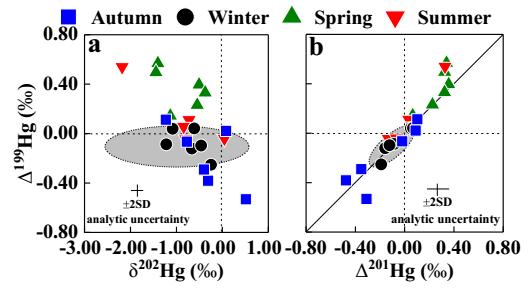 |
|
Fig. Relationships between Δ199Hg and δ202Hg (a) and Δ201Hg (b) for 23 PM2.5samples. (Image by IGCAS)
| Mercury (Hg), a globally distributed hazardous metal, is emitted to the atmosphere through natural and anthropogenic processes or reemission of previously deposited legacy Hg. It had three operationally defined forms including gaseous elemental Hg (GEM), reactive gaseous Hg (RGM) and particle-bound Hg (PBM). Although Hg isotopes in both GEM and RGM have drawn much attention, those of PBM are comparably less studied in the literature.
As one of the largest Hg emission countries in the world, China contributed a total estimated anthropogenic Hg emission of approximately 356 t in 2000 and 538 t in 2010. One important carrier of Hg is haze particles, especially PM2.5 that are actually among the most serious atmospheric pollutants in urban areas of China.
For the first time, HUANG Qiang from Prof. CHEN Jiubin’s group at the Institute of Geochemistry, Chinese Academy of Sciences (IGCAS) used mercury stable isotopes to trace the sources of Hg in haze particulate (PM2.5) in Beijing, China.
Since 2013, the researchers have established a high accuracy analysis method for haze particulate mercury isotopes, which allowed for systematically investigating the pollution sources and geochemical behavior of atmospheric particulate mercury. By combining the seasonal variation of both mass-dependent fractionation (MDF) and mass-independent fractionation (MIF) of Hg isotopes with geochemical parameters and meteorological data, they measured Hg isotopic compositions in potential source materials and PM2.5 samples collected in four seasons, and then successfully identified the sources of PM2.5-Hg and the possible atmospheric particulate Hg transformation.
The results suggested that major potential sources of PM2.5-Hg made variable contributions in four seasons. Continuous industrial input (e.g. smelting, cement production and coal combustion) contributed over the year, whereas coal combustion dominated in winter and biomass burning mainly found in autumn. In addition to the local and/or regional anthropogenic emissions, long-range transported Hg was probably also a contributor to PM2.5-Hg, accounting for the relatively higher odd-MIF particularly found in spring and early summer.
The study not only reported the sources and migration of particulate Hg by isotopes, but also showed that the metal (non-traditional) stable isotopes have an important application in tracing the sources and pathways of both particles and heavy metals at the same time. Moreover, the abnormally high enrichment factors of metals (such as mercury) in haze particles also emphasize the importance of further research on heavy metals in atmosphere particles and the relative health threats.
The study was supported by Natural Science Foundation of China(No. 41273023, U1301231, 41561134017), National “973” Program (No. 2013CB430001), “Strategic Priority Research Program” (No. XDB05030302) and the Chinese Academy of Sciences, and China Postdoctoral Science Foundation (No. 2014M550472).
An article on the results of this study entitled “Isotopic composition for source identification of mercury in atmospheric fine particles” has been published in Atmospheric Chemistry and Physics.
Contact:
CHEN Jiubin
Institute of Geochemistry, Chinese Academy of Sciences
E-mail: chenjiubin@vip.gyig.ac.cn
(By Prof. CHEN Jiubin’s group)
 |
 |
|